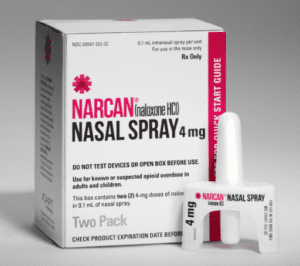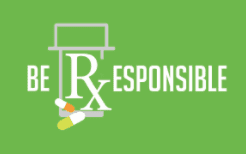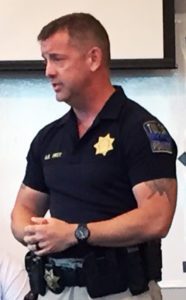 By Kelli Williams
By Kelli Williams
City of Bartlesville
Unintentional opioid drug poisoning has reached epidemic proportions in the U.S., with thousands of Americans dying from overdose each year. Combined with methamphetamine, the drugs were to blame for 899 deaths in Oklahoma in 2016 alone, according to the Oklahoma Bureau of Narcotics. Thirteen of those deaths were in Washington County.
In an effort to help stop the death toll from climbing, all Bartlesville Police Department officers were recently issued naloxone kits — a life-saving rescue drug that voids the effects of opioid-based drugs in the body.
Better known by the brand name Narcan, the drug has proven to be safe and easy to administer, and is responsible for saving countless lives, Tulsa Police Department Officer Anthony First told BPD supervisors during a Narcan training class held earlier this month. First, a Tulsa Police Department Special Operations Team paramedic, medical support and training officer, provided the training prior to the issuance of Narcan to BPD officers.
How it works
“What Narcan does is just void out the effects of the opioid. It doesn’t ‘do’ anything else to you,” First said. “It goes into the bloodstream and voids out the opioid, which makes their breathing pick up again. And that’s what’s going to save their life.”
Opioid-based drugs include codeine, fentanyl, hydrocodone, methadone, heroin, morphine and oxycodone. According to First, growth in the use of the painkiller fentanyl has proven to be the game changer in causing the number of deaths due to opioid-based drugs to skyrocket is the U.S. — including in Oklahoma.


“We love our pills in Oklahoma,” First said. “We’re No. 5 in the country for the number of pills that are prescribed. And of course we’ve had heroin around for a while, but heroin is (only) about 15-20 percent pure. It’s just not that good. Well, enter fentanyl. Fentanyl entered our market about two years or so ago. On the east coast and other parts of the country it’s absolutely brutal, and it’s getting that bad in Oklahoma.”
First said that while all opioid-based drugs are powerful, fentanyl is in a class by itself.
“If you imagine morphine being a ‘One,’ your oxycontins and hydrocodones are maybe about five times as powerful,” he said. “They’re not meant to be super powerful, they’re meant to just make some pain go away. Fentanyl, which is 100 percent pure, and this is what we’re seeing on the streets, is 100 times more powerful than morphine. So you can see that when folks use this, they’re going down immediately.”
The numbers: Oklahoma
First said the number of overdoses due to fentanyl is growing everywhere, prompting Oklahoma to start offering equipping law enforcement with Narcan in 2014.
“To give you some idea of how bad our overdose problem is — mainly because of fentanyl — there are parts of the country where agencies that used to have one or two a month now are now having 10 to 20 a day,” he said.
“We lose two people a day in Oklahoma (to opioid drugs). We have more people die in Oklahoma due to (opioids) than we do car crashes.”
And while many of these overdoses involve people who use the drugs illegally, they’re not the only ones, First said.
“It’s not just people who are using drugs recreationally, illegally,” he said. “It’s also kids who get in their parents’ medicine cabinets, and older folks who mix up their medications.”


In Washington County, more than 800 overdoses have been reported in the last four years, according to the Washington County Wellness Initiative, a local non-profit agency that has partnered with the Cherokee Nation to work toward reducing prescription drug abuse in Washington County.
According to WCWI, 71 people died from accidental overdose in Washington County between 2007 and 2015. Fifty of those involved prescription drugs and 42 involved prescription painkillers. Between 2012 and 2016, Jane Phillips Medical Center reported 830 overdoses, and 171 overdoses were reported by JPMC in 2016, according to WCWI records.
“We are seeing more deaths locally from opioid drug use,” said BPD Detective Jim Warring, who works with the WCWI on drug-related education. “We have heroin on the east coast filtering this way, and Mexican drug cartels are getting into the poppy business. These drugs are here now and are trending toward an even larger presence in the future. Unfortunately, this is a problem that is probably going to get worse before it gets better.”
Police Chief Tom Holland said the decision to issue Narcan to BPD officers was an easy one.
“The Bartlesville Police Department joins a long list of law enforcement agencies in Oklahoma that are now issuing Narcan to their officers,” Holland said. “I’m sure we all wish this wasn’t necessary, but the fact is these drugs are killing people. And if there is something the police department can do to help stop that, we are more than willing to do it.”
Statewide response
In fact, 64 percent of all law enforcement officers in Oklahoma are currently able to administer the rescue drug. According to First, Narcan has been deployed by law enforcement officers across the state 108 times since it began to be used in 2014, with 88 “reversals.” In Tulsa, Narcan has been used approximately 40 times with 34 reversals, he said.
“And that’s just law enforcement,” he said. “Many of these ‘saves’ are made by family members,” he said.
Narcan is available at most pharmacies and does not require a prescription. The cost of a Narcan kit, when purchased retail, is approximately $50. Narcan kits for Oklahoma officers and other first responders are funded and provided by the Oklahoma Department of Mental Health and Substance Abuse Services.


First acknowledges some agencies in the U.S. are having a problem paying for the amount of Narcan that is needed, citing costs in Florida, Ohio and Michigan as upwards of $200 per dose.
“And they’re using it ten to twenty times a day,” First said. “So you can see what it’s doing to their budgets. It’s so bad, at least two cities have tried to pass municipal ordinances saying that if (law enforcement) has to revive you more than two or three times, you’re done.
“Fortunately, none of those have passed,” he said.
First also addressed a sentiment in some communities of reluctance to offer Narcan because it is felt the drug “makes the problem worse.”
“I get that,” First said. “The problem is massive. It’s too big for anyone in this room to fix. But what we can affect is what’s happening right in front of us — what’s happening in the living room we’re standing in when a mom finds her kid not breathing. Or what happens when we go to a high school and find a student, maybe a kid of one of our fellow officers, not breathing.
“At the end of the day, if it was your kid, how many times would you do it? Would you have a cut-off number? If it was your mom or dad, would you get to number six and say, ‘You know what? We’re just making the problem worse. I’m not going to do it anymore.’ All these folks are someone’s kids, they’re someone’s mom, someone’s dad.
The effects
According to First, Narcan takes about 30 seconds to administer. One dose of Narcan is four milligrams, and while one dose generally revives the patient, sometimes two doses are required. (BPD officers are equipped with two doses.)
“If that doesn’t do anything whatsoever, chances are it was not opiate-based,” First said.
Drugs that can prompt a similar effect of an opioid-based overdose include alcohol, Xanax and methamphetamine. Narcan will not revive those patients, he said.
The drug is administered through the nose and “is good” for only about 60 minutes. Chest compressions may be necessary if there is no pulse, First said.
“If it’s an (opioid-based) problem, you should see them start to recover in about a minute or so,” he said. “Their breathing will improve, their skin will look a little better. They may or may not awaken, that depends on what (drugs) they’ve got in them. But they will improve and get out of that life-threatening situation within about a minute or so.”
Because the effects of Narcan wear off within an hour or so, overdose victims should receive medical care even after Narcan is given, First said. BPD officers administering Narcan will remain with the patient until medical help arrives.
Good Samaritan Law
Law enforcement officers in Oklahoma are permitted to administer the life-saving drug under the Good Samaritan Law, which, as of Nov. 1, now includes protection specific to the administration of naloxone (Narcan).
“We’re grateful to our legislators for adding this extra layer of protection for our officers,” said City of Bartlesville Administrative Services Director Mike Bailey. “We were always covered under the Good Samaritan Law, but this addition goes a little further and specifically protects law enforcement in administering naloxone, or Narcan.”
Project: Save lives
BPD Patrol Capt. Rocky Bevard said that while law enforcement will continue in their efforts to combat drug trafficking and other serious crimes, the Narcan project is purely a life-saving effort and should not be confused with drug enforcement.
“This is not an enforcement issue,” he said. “We want everyone, no matter who it is, to feel comfortable approaching a Bartlesville police officer and asking for help.”
According to First, while Narcan can save the life of a child or someone accidentally exposed to opioid drugs, it can also offer a second chance to those who use the drugs illegally.
“If we can keep that person alive long enough to get to that nine-year mark, when most people are able to get clean from an opioid-based problem, we can get them back to their families — we can get them back to their friends, to their jobs and their schools,” he said. “It’s a win-win for everyone.”
